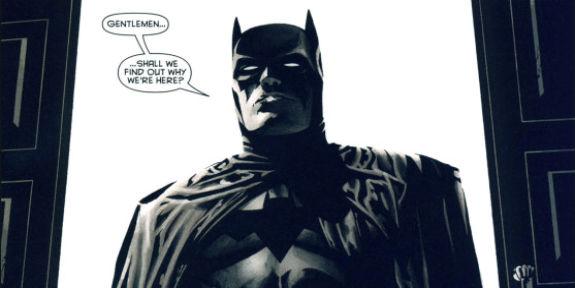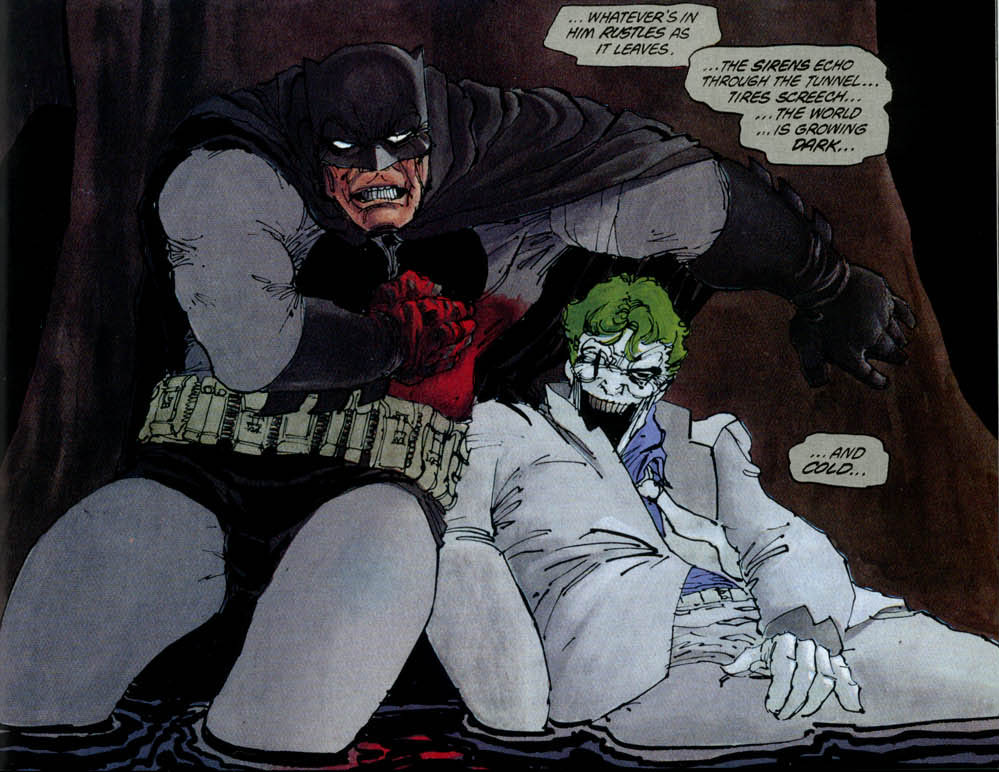Building a Better Batmobile: The Morrison Batman (Part 1)
Part 1: The Morrison
(and Miller) Batman Before Morrison’s Batman Run Begins
Oh man, it’s been 4 years since my very first post here,
and it’s my 100th post SIMULTANEOUSLY. To celebrate, let’s talk about Batman.
(nu-na-nu-na-nu-na-nu-na-nu-na-nu-na-nu-na-nu-na-nu-na-nu-na-nu-na-nu-na-Bat-man!)
And by “talk about Batman” I actually mean “start a
series of articles on Batman”. Because I
have a lot to say about Batman, you guys.
Spoilers for
comics! (Some of them more than 20 years old, others that just came out a
few months ago…)
Warner Brothers recently released Part 2 of their animated
adaption of the Frank Miller-Klaus Janson classic The Dark Knight Returns. If
you aren’t familiar at least in some way with the comic, I have no idea what
you’re doing here, but welcome! Short
version, TDKReturns sort of redefined
Batman in a some ways (but probably not as many as it gets credit for). TDKR and
Miller’s follow up Bat-story, Batman: Year
One (with David Mazzucchelli on the art side) were largely responsible for
a resurgence in Bat-Mania, and both had a huge impact on the Batman films from
Tim Burton and later from Christopher Nolan (multiple scenes from Batman Begins were lifted wholesale from
Year One). Basically, the “Miller Model” of Batman
became the standard version of the character in the mid-80’s, replacing the late
60’s “O’Neil Model”.
(The “Miller Model” of Batman, submitted rather unfairly without
context)
Now this is not a review of the cinematic version TDKRrturns, because I find it difficult
to really review it. They made some
interesting style choices, but ultimately they stuck as close to the source
comic as possible, almost to the point of fanaticism. They didn’t want to make a Batman movie based
on a comic; they wanted to turn a comic into a movie verbatim. The one major aspect of the comic that they
dropped was something that could never come off as anything other than cheesy
in a movie: In the comic, nearly every single major character is given to
literary narration of the events unfolding around them. You really dive into the characters heads,
understanding their motivations and personalities, because their thoughts inform
your views of them. In the comic, it’s
genius. My favorite bit is from one of
these “narrative thought boxes”, after the Joker has murdered a few hundred
talk show audience guests. “No, I don’t keep count {of the bodies]” Joker
thinks. “But you do…”
("…And I love
you for it.")
And then he murders a bunch of cub scouts with poisoned
cotton candy. Super creepy, and super
awesome.
A comic is all visual, though, and movies are both visual
and audible. In a film, the only way to
know exactly what a character is thinking is for them to either say it out loud
on screen, or to have them narrate the film as it goes along. And multiple voice overs throughout the
entire movie would get pretty boring and possibly confusing very quickly- so
the filmmakers (fairly wisely) just cut them out. It was probably the smartest way to go, but
it also completely changes the dynamic of the story. Now, instead of reading the thoughts and
feelings of the characters, all I can see is their actions. Removing the internal monologue of TDKReturns turns it into a fairly linear story
that becomes VERY violent and weirdly political about the Reagan years, and
then Batman just punches the living shit out
of Superman. That caught me off guard
watching the film*, but perhaps it shouldn’t have.
I’m not saying that’s bad. Actually, it’s quite revealing, and
telling. It’s telling because of what
came after Miller’s run; the popularity of his interpretation meant that many
writers tried to imitate his style. Most
of them have done it quite poorly. As a
general rule, they’ve missed the heart of the story, just like this film does,
by not fully understanding the context, and thus they have rendered a Batman
that is a morally questionable, bizarrely asexual, repressed, violent, crazy
person. And make no mistake, a lot of
people like Batman like that, and of course, he is a character open to multiple
interpretations. There are plenty of
Batman stories that take the character as deadly serious. I just think they’re acting like 12 year
olds, and so does (I think) Grant Morrison.
Morrison has, in one way or another, been writing Batman
for 25 years. Starting with Arkham Asylum: A Serious House on Serious
Earth, through Gothic: A Romance,
his JLA run, and the Batman stories
(over multiple titles) he’s been writing since 2006, Morrison has been working
to redefine the character. The “Morrison
Model” has been called several things before: “Zen master”; “ultimate planner”;
in his comics Morrison has had characters state that Batman is “the most
dangerous man on the planet” and that “Batman thinks of everything”. I have my own suggestion. The “Morrison Model” of Batman is that Batman
is constantly trying to make himself a more perfect man. And almost every Batman story he’s been
telling has been directly about that.
(This is the cover.
It’s the first indication that this is not a typical Batman story)
Rebuilding Batman and making him better was Morrison’s
original goal in Arkham Asylum. It’s April Fool’s Day, the Joker and crew
have taken over the Asylum, and they’ll only surrender if Batman will descend
into the darkest pits of the madhouse and confront it’s- and his- psychological
demons. By taking all the parts of the
then-recently developed “Miller Model” of Batman, and forcing the character to
be confronted by all of his intimate fears, by his entire psychosis, Morrison’s
goal was to “fix” the character, so that we could have Batman books that weren’t
so obsessed with how irrational Batman’s actions were. Along the way we got a really trippy journey
through the madhouse, the expanded history of the mad house’s founder, and lots
of talk about magic and tarot and stuff.
In the end, Harvey Dent gets to be the subtle savior of Batman, earning
his own moment of redemption. It’s also
a little too on the nose about all the maternal feelings and stuff, but maybe I’ve
just read it a few too many times.
(The Joker, in Arkham
Asylum. This is definitely not a
typical Batman story.)
Maybe it’s because it was a little too dark and brooding,
maybe because it wasn’t done in the “DC house style”, or maybe just because
fanboys don’t know what’s good for them, but Morrison’s attempt to fix things
didn’t really take. His follow up, Gothic is fine, but by no means
essential. Following a lot of the same
theme’s as Arkham, Gothic takes place in Batman’s early
years, and deals with a mystic enemy. Mister
Whisper is an evil monk, promised 300 years of life in exchange for his soul
has almost run out of time on that barter.
The Sacred Architecture stuff that was mostly just implied in Arkham is brought to the forefront
here. And instead of focusing on Bruce’s
mother, it’s his father that gets the spot light. Rather than a Deus ex machine, it’s the Devil
in the Machine that wraps up this story- which is mostly interesting because
Morrison would return to that theme 15 years later. There’s lot’s of Gotham as hell, evil
cathedrals, and Don Giovanni is thrown into the mix. Whisper is pursued by two devils, Batman (see
the ears) and a young girl who is more than she appears. There’s more to it than that, but again, not
all that important for “Morrison’s Long Run”.
(Batman: He is King of Hell.)
What is essential is Morrison’s JLA run. It’s awesome, and
if you haven’t read it, you absolutely should.
I’m not going to go into too much detail on it, because there’s a lot to
it and there are a whole bunch of story arcs.
What matters here, though, are Batman’s interactions with the team. Morrison’s JLA pretty much lives and breathes on the idea that Batman always
has everything figured out. He’s always
6 steps ahead of everybody, good guys and bad guys included.
(Batman: He knows your secret.)
Since all the writers in the regular Bat-books were
basically still ape-ing Miller’s take, Morrison decided to trail-blaze his take
interpretation of the character in JLA. And in many ways, Batman gets the best
character arc of any of the “big seven”.
It’s not a huge emotional roller coaster or anything, but trust me, when
Bats takes down Prometheus, the moment feels earned.
(Trust me, this feels earned.)
But if you had to sum up Morrison’s take on Batman (so
far) in one page, it would be this one:
(Spoiler: Batman’s Flying Saucer had, in fact,
arrived. From his Flying Saucer
Factory. That he owns.)
“Don’t tell my friends in the G.C.P.D. about this.” As if to say “Fine, fine, you ‘serious’ kids
can have your dark, brooding Batman in his (many) solo books. What with your evil clowns and clay
monsters. That are serious. Now, if you’ll excuse me, I have a city of possessed
superheroes to save from an evil telepathic gorilla.” Morrison’s Batman embraces how truly weird
superhero stories are, and it revels in it.
The concept of Batman is “Dude in a Dracula costume punches bad dudes
dressed in question mark costumes.” It’s
totally ridiculous! Which is fine,
because it’s totally awesome too! Why
does everybody take this so seriously?
And so, after a decade of, off and on, writing a Batman
that was king of the awesomes, Morrison was handed the solo Batman book. And what was the first thing he did with
it? He saddled Batman with a kid he
never knew he had. Trust me, this will
all make sense eventually.
Next time: Batman and Son! Plus some other stuff too!
*=Not the shit-punching out of Superman, the graphic violence. To be clear.









Comments
Post a Comment